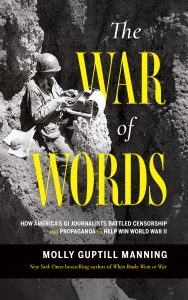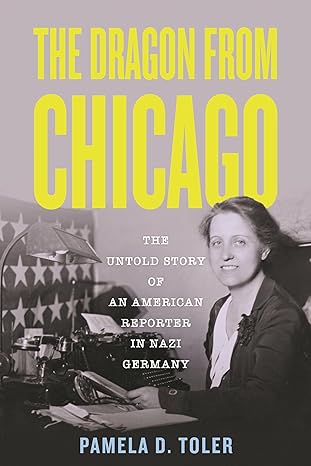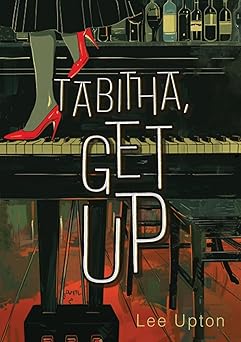My Journey Writing The War of Words
My Journey Writing The War of Words
By Molly Guptill Manning

Photo by Martin Bentsen.
When I was a history student in college, I wondered how authors of historical non-fiction found new stories about events as well documented as World War II. With thousands of titles already in print, what tales are left to tell? As I celebrate the publication of my third book about this time period, I would tell my younger self that untold stories abound, and their discovery requires a combination of curiosity, open-mindedness, a willingness to dig through archives, and luck.
The idea for my latest book, The War of Words, came to me via a fortuitous email from a World War II veteran. In 2014, he happened to read my second book, When Books Went to War, which tells the true story of how the U.S. military armed its troops with books to boost morale, quell homesickness, and counter misinformation. Over 140 million books were distributed to troops, and American reading habits were never the same again.
“When MAGAZINES Went to War,” read the subject line of the email written by Gil Sandler. Sandler said that very few books reached his ship during his two years with the Navy in the South Pacific. But everyone on his ship read. Voraciously. Their reading ration, he explained, came in the form of miniature periodicals from home—The New Yorker, Time, Newsweek, etc.—and newspapers that troops wrote and printed for themselves. I was already well-versed in the miniature magazines. But troop newspapers? Other than the Stars and Stripes and Yank, I was not aware of troops printing their own gazettes. I was intrigued. As I did some digging to better understand what Sandler had described, I happened upon an incredible story—one entirely forgotten by the passage of time.
I soon learned that homespun GI newspapers were as ubiquitous as K-rations and combat boots. As troops were making history, they had few places to record it. Their letters home were severely censored and diaries were prohibited. But, surprisingly, the War and Navy Departments permitted troops to print newspapers, and newsprint became the only place where troops could chronicle their war stories. During World War II, over 4,600 unique newssheets “by and for troops” made their debut at Army training facilities, aboard Naval vessels, in trenches across Europe, on remote Pacific islands, and anywhere else where there were troops, ink, and paper. The more I learned, the more I felt that the story of these newspapers needed to be told and preserved.
For years, I scoured archives and read as many GI newspapers as I could find. Each gazette felt like a literary time capsule, capturing the essence of the lives of the soldiers who produced it. Whenever I discovered dozens of issues of a unit’s newspaper, I eagerly read the entire collection, quickly becoming invested in the fates and concerns of those covered in the paper. It was impossible to not feel their angst of not knowing when their next battle would erupt and just how deadly it might be. I laughed at their jokes, teared-up as they mourned lost buddies, rolled my eyes at some of their attempts at poetry, and felt a sense of appreciation for these troops who bothered to write down their experiences. I could feel how much it mattered to them to have their stories committed to paper so they would be remembered. By the time I turned to the last issue of a unit’s paper, I felt that I had become part of the gang and was sorry to part ways with them.
Reading GI newspapers was the easy part. Piecing together the story of how they came to exist was difficult. Neither the War nor Navy Departments preserved records for the newspaper programs they endorsed during World War II. Rather, most records were informal and were created by the journalists and artists who worked on a paper. This meant that the story I wanted to tell was scattered across archives, books, newspapers, and personal papers. Finding the information I needed required creativity and persistence. For years, I combed through musty documents and brittle newsprint. Though this may sound tedious, it felt like I was on a massive scavenger hunt—sifting through hints and clues to discover new paths to investigate.
The finished book tells the story of how, eighty years ago, American troops lugged typewriters into war zones, wrote stories and sketched illustrations of their experiences, hand-cranked newspapers off mechanical presses, and distributed these papers to those in neighboring foxholes, bunks, and huts. After reading, many troops mailed their newspapers home for safekeeping and so their loved ones could get a glimpse of war. Today, these old newspapers can be found in attics, tucked into old filing cabinets, stashed alongside other war mementoes, and some have made their way into war museums and archives. It is my hope that by telling the story of these humble newssheets, readers will be connected to some of the long-lost stories that war veterans committed to print so we would never forget them.
—
Molly Guptill Manning is the author of the New York Times bestseller When Books Went to War as well as The Myth of Ephraim Tutt. She has published articles in the Columbia Journal of Law and the Arts and the Cornell Journal of Law and Public Policy. She was a supervisory staff attorney for the United States Court of Appeals for the Second Circuit in New York City and is currently an associate professor at New York Law School.
Find out more about Molly on her website https://www.mollymanning.com/
The War of Words : How America’s GI Journalists Battled Censorship and Propaganda to Help Win World War II
 From New York Times bestselling author Molly Guptill Manning comes The War of Words, the captivating story of how American troops in World War II wielded pens to tell their own stories as they made history.
From New York Times bestselling author Molly Guptill Manning comes The War of Words, the captivating story of how American troops in World War II wielded pens to tell their own stories as they made history.
At a time when civilian periodicals faced strict censorship, US Army Chief of Staff George Marshall won the support of President Franklin Delano Roosevelt to create an expansive troop-newspaper program. Both Marshall and FDR recognized that there was a second struggle taking place outside the battlefields of World War II—the war of words. While Hitler inundated the globe with propaganda, morale across the US Army dwindled. As the Axis blurred the lines between truth and fiction, the best defense was for American troops to bring the truth into focus by writing it down and disseminating it themselves.
By war’s end, over 4,600 unique GI publications had been printed around the world. In newsprint, troops made sense of their hardships, losses, and reasons for fighting. These newspapers—by and for the troops—became the heart and soul of a unit.
From Normandy to the shores of Japan, American soldiers exercised a level of free speech the military had never known nor would again. It was an extraordinary chapter in American democracy and military history. In the war for “four freedoms,” it was remarkably fitting that troops fought not only with guns but with their pens. This stunning volume includes fourteen pages of photographs and illustrations.
BUY HERE
Category: On Writing

























